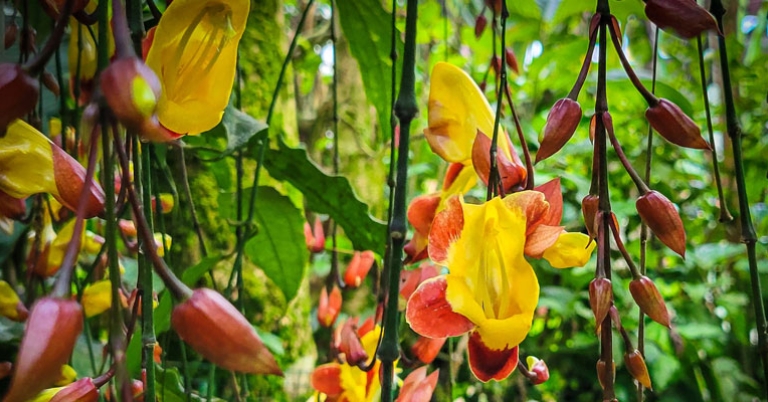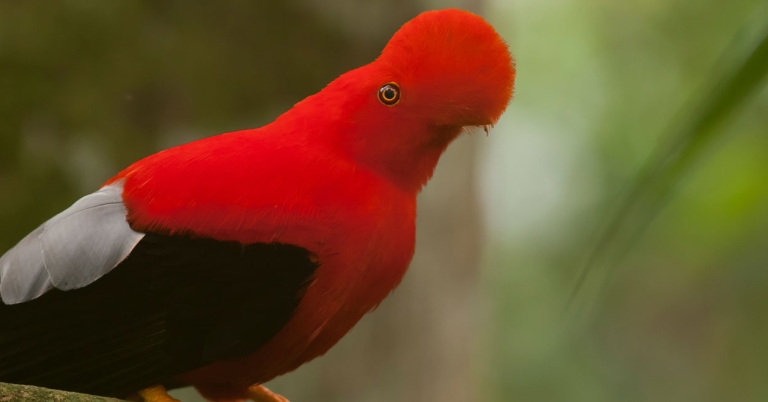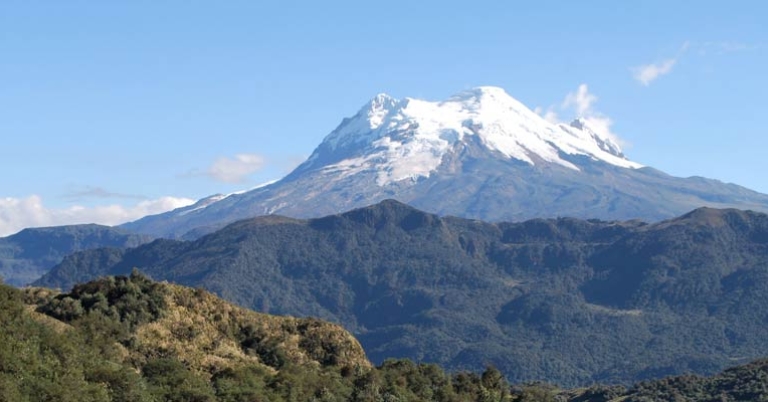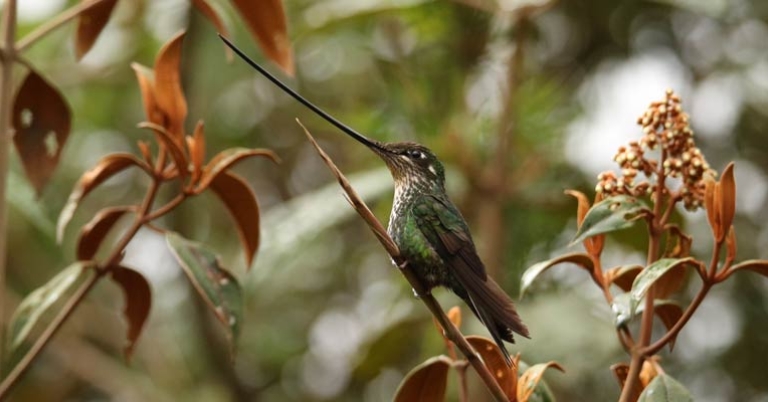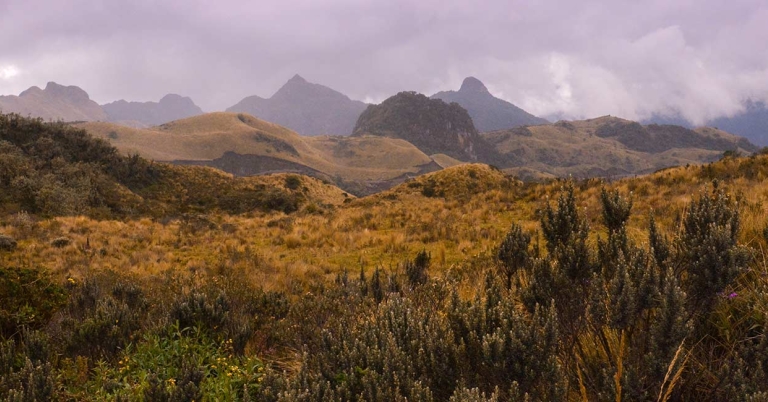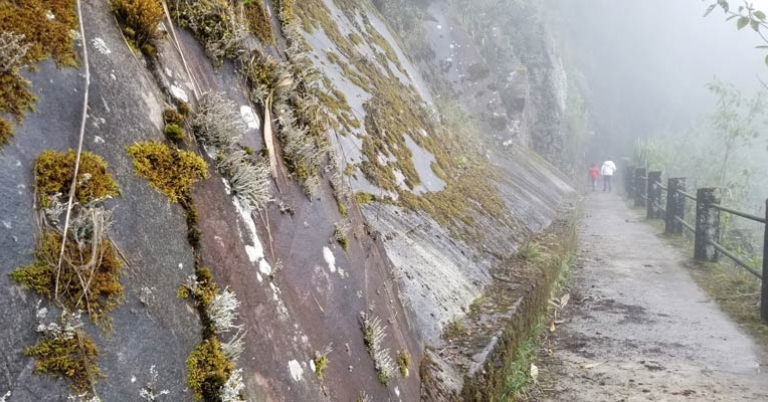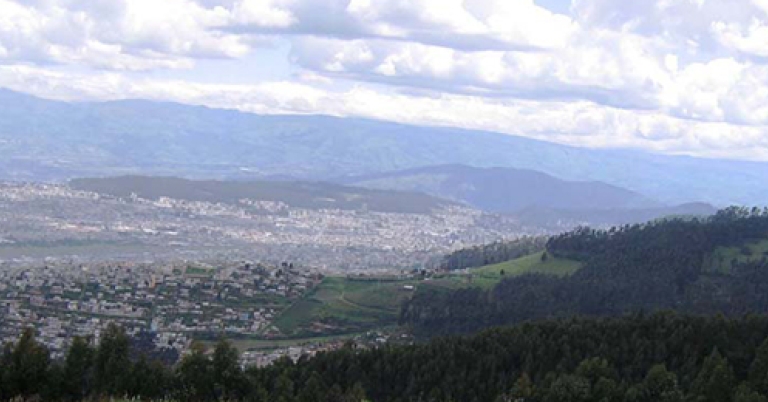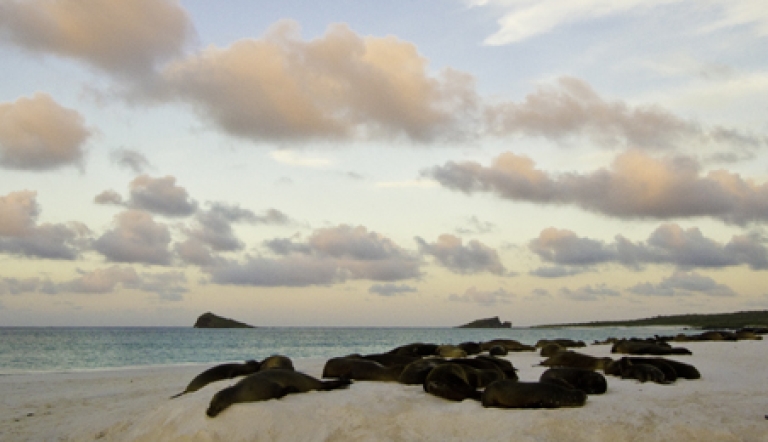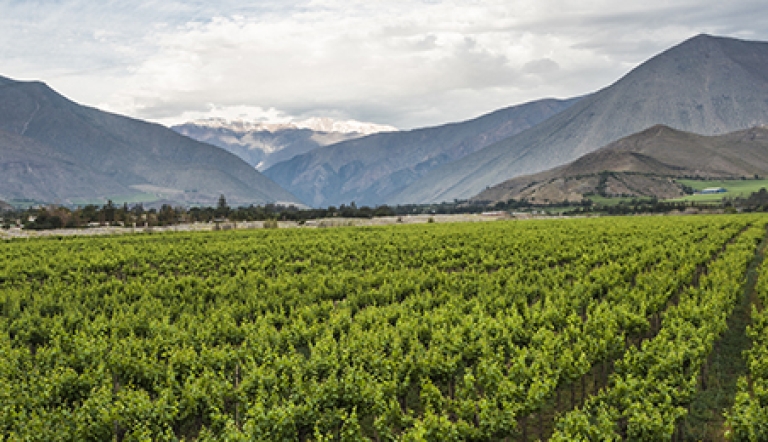Ecuador | Optional Pre-trip Extension: Nature and Wildlife in the Andes
About this trip
 An extraordinary abundance of life inhabits the forests of northwestern Ecuador. Amid subtropical and montane forests, rainforest, páramo, and the eastern and western slopes of the Andes Mountains, you’ll seek out as many of the country’s 1,640-plus species as possible with assistance from your expert guide on this five day pre-trip adventure (see main Galápagos program here). In particular, much of the fauna you’ll encounter is endemic to the Chocó region, while other species are more easily found here than any place else. Along the way, view the snow-capped Antisana Volcano and straddle the equator at the Middle of the World Monument.
An extraordinary abundance of life inhabits the forests of northwestern Ecuador. Amid subtropical and montane forests, rainforest, páramo, and the eastern and western slopes of the Andes Mountains, you’ll seek out as many of the country’s 1,640-plus species as possible with assistance from your expert guide on this five day pre-trip adventure (see main Galápagos program here). In particular, much of the fauna you’ll encounter is endemic to the Chocó region, while other species are more easily found here than any place else. Along the way, view the snow-capped Antisana Volcano and straddle the equator at the Middle of the World Monument.
Highlights
- Explore the Chocó ecoregion across a variety of protected areas, including Yanacocha Biological Reserve and the Antisana Ecological Reserve.
- Visit the famed Refugio Paz de las Aves, known as a haven for rare wildlife.
- Learn about the work of Aves y Conservacion and the community nursery Alambi.
- Explore the Mashpi-Amagusa Reserve for beautiful fauna unlike any other.
Meet your leader
 Jim White
Jim White
Jim White has worked at Delaware Nature Society since 1982 where he has directed the Delaware Nature Society’s land and biodiversity management program. A native Delawarean, he attended the University of Delaware. Jim is dedicated to the protection and management of Delaware’s native species and the habitats where they live. His primary natural history interests include, insects, amphibians, reptiles and birds. He teaches herpetology at University of Delaware and with his wife has published a field guide to the Amphibians and Reptiles of the Delmarva Peninsula. He has written extensively on Delaware’s biodiversity and speaks regularly on the topic. Jim also leads natural history trips to many natural areas in the US and in Central and South America including the Galapagos Islands.
$1,550
Per person
About this price
Land cost only. Does not include round-trip airfare to and from destination.
Single room supplement $295
Daily Itinerary
Print ItineraryQuito
Mindo
Mindo
Sangolqui
Puembo
Pricing
Print Pricing$1,550
Per person
About this price
Land cost only. Does not include round-trip airfare to and from destination.
Single room supplement $295
Pricing Details
A $200 per person deposit and enrollment form is due to hold your space on this trip. The deposit is refundable less $100 cancellation fee until 95 days prior to departure. Cancellations after this date will result in loss of full deposit.
Cancellations after this date will result in loss of full deposit.
Holbrook Travel strongly recommends the purchase of travel protection for medical emergencies while traveling and to protect your investment. Please note the purchase of Cancel for Any Reason Coverage or to exclude pre-existing conditions with Trip Cancellation coverage may require policy purchase within 10-14 days of your initial deposit, depending upon the provider.
Single room supplement $295
Final payment due date: March 21, 2023
Travel Info
Print Travel InfoEntry & Exit Requirements
U.S. citizens must have a valid passport to enter Ecuador. Passports must be valid for at least six months after the date of departure.
For visits fewer than 90 days, visas will be issued upon arrival in Ecuador. Tourists may be required to provide evidence of return or onwards travel.
If you are not traveling with a U.S. passport, please check with the Embassy of Ecuador for the requirements based on your nationality.
Health Information
IMMUNIZATIONS
The Centers for Disease Control recommends that all travelers be up to date on routine vaccinations such as measles-mumps-rubella (MMR) vaccine, diphtheria-pertussis-tetanus vaccine, varicella (chicken pox) vaccine, and your yearly flu shot before every trip.
There are no vaccinations required for entry into Ecuador (unless you are arriving from Brazil, Democratic Republic of the Congo, or Uganda, in which case proof of yellow fever vaccine is required).
The CDC recommends inoculation against hepatitis A, hepatitis B, and typhoid for most unvaccinated travelers to Ecuador.
Yellow fever is a risk in certain parts of Ecuador, primarily at elevations below 7,500 feet. In addition to protecting against mosquitos, the CDC recommends the yellow fever vaccine for travelers who will be at elevations below 7,500 feet east of the Andes.
Please consult your physician for additional information and recommendations based on your individual circumstances.
MALARIA
The CDC warns that malaria is a risk in certain parts of Ecuador, primarily at elevations below 5,000 feet. Malaria is caused by a parasite found in Anopheles mosquitos, which are active from dusk until dawn. In some areas of Ecuador (particularly in parts of the Ecuadorian Amazon), the CDC recommends the use of anti-malarial drugs combined with mosquito avoidance; in other regions, they recommend mosquito avoidance only. To protect against mosquitos, cover exposed skin with lightweight, long-sleeved shirts and pants, consider treating clothes with permethrin, and use an insect repellent containing an active ingredient like DEET or picaridin. Apply sunscreen first, followed by the repellent (preferably 20 minutes later). If you choose to use an anti-malarial drug, please consult your physician.
Dengue Fever & other insect-borne illnesses
The CDC warns that dengue fever is a potential risk in Ecuador. In addition, locally transmitted cases of Zika virus and chikungunya have previously been reported. The CDC recommends that travelers to Ecuador protect themselves against mosquito bites.
As a precaution, the CDC advises women who are pregnant to consider postponing travel to any area where Zika virus transmission is ongoing.
ALTITUDE SICKNESS
Upon arrival at locations of high elevation, shortness of breath and a pounding heart are normal responses to the lack of oxygen in the air. However, for some visitors, these symptoms can deteriorate into altitude sickness. Headache, extreme tiredness, dizziness, nausea, and loss of appetite are standard symptoms. Staying hydrated and well rested is important to adjust to the altitude. Avoiding heavy, fatty foods and alcohol in the days before arriving to altitude can help. Over-the-counter medications are also available to help prevent or alleviate symptoms. It’s advisable to avoid sleep medications, as they can slow breathing and respiration, which aid in getting the blood oxygenated while sleeping. Participants who take blood pressure medications should discuss this with their doctor as the medication can drop pressure too low at times.
SUN EXPOSURE
The effects of the sun can be damaging to the eyes and skin. Spending time outdoors exposes you to the sun’s harmful ultraviolet (UV) rays, even on cloudy days. To protect yourself from the sun, use a broad spectrum sunscreen of at least SPF 15, protect skin with clothing, wear a wide-brimmed hat and sunglasses, and drink plenty of fluids.
Resources
Print ResourcesPacking Recommendations
Everyone has personal preferences when it comes to packing; for this reason, the information below is offered as a general guide and not a definitive list. You know yourself best: Use your discretion and pack what you think will serve you, based on your personal preferences and specific itinerary.
You may find many of the items below in our Gear Store.
CLOTHING
Bring enough clothing suitable for the length of your program. If you prefer to pack light, note that many hotels offer laundry services at additional cost. If you plan to hand-wash items, remember that humidity may delay drying time.
Pack clothing that can be worn in layers to adapt to weather changes throughout the day. If your program includes visits to higher elevations, warm clothing is strongly recommended. Temperatures can get quite chilly, especially at night and early in the morning, and hotel rooms don’t always have heat. It can also be windy at times. Consider packing a warm underlayer, as well as a warm, protective outer layer.
- A combination of short-sleeved and long-sleeved shirts
- Shorts
- Lightweight, quick-drying long pants for sun and mosquito protection; jeans tend to be uncomfortable in hot and humid conditions, but are fine in the cooler highlands.
- Undergarments
- Sleepwear
- Lightweight jacket or sweater/sweatshirt (or heavier weight if visiting high-elevation areas)
- 1-2 bathing suit(s) for the beach or hot springs, if applicable, plus many hotels have pools
- Socks – Bring extra pairs. If your itinerary indicates muddy hikes with rubber boots provided on-site, pack a few pairs of knee socks to prevent blisters.
- Shoes – Consider your specific itinerary when choosing footwear. For most programs, you’ll likely want at least one pair of comfortable, closed-toe walking or hiking shoes suitable for forest hikes and walking over cobblestones or other uneven terrain. Sturdier hiking boots may be appropriate for more rugged itineraries. In addition, many participants opt for a pair of sturdy sport-strap sandals (e.g. Keens, Tevas, or similar) and/or casual flip-flops or sandals. If you’re visiting the beach, you may also want a pair of aqua socks, reef walkers, or water shoes.
- Lightweight rain jacket, hooded poncho, and/or windbreaker
- Visor or wide-brimmed sun hat; wool hat or beanie for higher elevations
- Bandana, scarf, or Buff-style headwear
Personal Toiletries
Pack toiletries based on your personal preferences and habits. Below are just a few recommendations to keep in mind.
- Shampoo, conditioner, lotion, deodorant/antiperspirant , etc. – If possible, avoid strong fragrances if you are sensitive to insect bites and in consideration of your fellow travelers.
- Soap and washcloth or a small, quick-drying microfiber towel – Washcloths are not standard in all hotels. If you normally use a washcloth, you may wish to bring one from home.
- Hairbrush, comb, hair ties, shower cap. Not all hotel rooms provide a hair dryer, so you may wish to bring one from home.
- Toothbrush and toothpaste
- Razor
- Ear plugs, especially if you are a light sleeper
- Personal hygiene products
- Insect repellent with DEET or picaridin (see note below about treating clothing with permethrin)
- Sunscreen and lip balm with SPF – If you’ll be in the ocean, we recommend reef-safe sunscreen.
- Aloe vera gel
- A travel pack of tissues – also useful as napkins or toilet paper if needed
In addition to your personal toiletries, it is useful to pack a small medical kit, which you can easily prepare. Helpful items might include: bandages, antihistamine, a pain reliever, motion sickness and/or altitude sickness medication (if you are prone to either), anti-diarrhea medicine, individually wrapped pre-moistened towelettes and/or hand sanitizer, antibiotic ointment, anti-fungal cream, moleskin for blisters, eye drops, tweezers, a mini sewing kit, and an extra pair of disposable contact lenses or eyeglasses if you wear them.
Days before you leave home, you may wish to consider spraying any clothing, socks, and shoes that will be worn in lowland, tropical sites with permethrin, an anti-parasite medication, to repel irritating pests and prevent the spread of disease. A recommended brand is Sawyer. Carefully read all instructions before use. Please note permethrin is highly toxic to cats and fish, and some aerosol products may be harmful to birds. Side effects may include minor itching, burning, or redness. You may want to use a laundry marker to label and keep track of which socks are permethrinized. Only one application per item is necessary; permethrin on treated clothes remains effective through several washings. Permethrin should NOT be applied directly to skin.
Miscellaneous
Remember to pack valuables such as your passport, cash/credit cards, and medications in your carry-on luggage.
- Passport and photocopies of all travel documentation
- Personal insurance card and travel insurance information
- Money – ATM/credit card, and/or cash; small bills in good condition are recommended
- Prescription medicines (if applicable), with a copy of the prescription
- Yellow fever certificate (if required; only if arriving from Brazil, Democratic Republic of the Congo, or Uganda)
- Sunglasses with strap
- Small day pack for hikes and excursions
- Flashlight and/or head lamp
- Travel alarm clock or inexpensive waterproof wristwatch with alarm – Not all hotels provide alarm clocks.
- A pocket calculator or phone to assist with conversions
- Binoculars with lens cleaner
- Camera and related equipment, such as charger, lenses, and extra memory cards
- Reusable water bottle
- Non-perishable snacks
- Pocket-knife or multipurpose tool - Pack in your checked luggage
- Zip-top style bags – useful for packing toiletries, sorting clothing, storing damp or muddy shoes, or as a dry bag for protecting electronics
- Notepad or travel journal and pen
- Music or reading material for down time, long bus drives, or on the airplane, and a portable bright light to read by
- Collapsible walking stick with rubber tip
- A small quantity of laundry detergent if you’ll be washing clothing by hand
- Travel-size umbrella – Some people find this unwieldy to carry, while others find it offers better protection than a rain jacket alone.
- Money belt
- Chargers for electronics

Questions
Contact Debbie Jordan at 866-748-6146 or debbie@holbrooktravel.com
